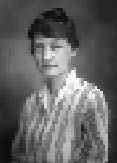Discovering The Power Within
Without Arthur Wesley Dow, imitative realism might have soured Georgia O'Keeffe on an artistic career
By Lisa Farmer
“In school, I was taught to paint things as I saw them. But it seemed so stupid. If one could only reproduce nature, and always with less beauty than the original, why paint at all?”
Today the world knows Georgia O’Keeffe as the creator of works such as “Blue and Green Music”, “Ram’s Head White” and “Poppy 1927”, which synthesize abstraction and representation. Yet at age 25, O’Keeffe—who had already studied at the Art Institute of Chicago and the Art Students League in New York City and won prizes—was on the verge of abandoning her dream.
Fortunately, O’Keeffe was not the only American artist who was fed up with imitative realism. At TC, Arthur Wesley Dow, who had become enamored of the shadowless space and stylized drawings of Chinese and Japanese artists, had begun preaching the Modernist idea that the subject of an artist’s work should be his or her own ideas and feelings.
“Art is decadent when designers and painters lack inventive power and merely imitate nature or the creations of others,” wrote Dow, founding chair of TC’s art education program, in his seminal textbook, Composition: A Series of Exercises in Art Structure for the Use of Students and Teachers. “Then comes realism, conventionality and death.”
O’Keeffe first learned of Dow during the summer of 1912, when financial concerns prompted her to take a teaching course at the University of Virginia. Her instructor was a visiting faculty member, Alon Bement, Dow’s colleague at TC.
By 1914, O’Keeffe had enrolled at TC and was working with “Pa Dow,” as she called him. Together with her classmates Anita Pollitzer and Dorothy True (believed to be the model for O’Keeffe’s painting, “Lady With Red Hair”), she visited Gallery 291, run by the photographer and art impresario Alfred Stieglitz, who gave Americans their first public display of Cezanne watercolors and works by Matisse and Picasso. The following year, O’Keeffe—now teaching in South Carolina—sent True drawings she had done in a new, abstract style. Unbeknownst to O’Keeffe, Pollitzer brought the work to Stieglitz, who was instantly impressed. “Finally, a woman on paper,” he is reported to have said.
Over the next several years, Stieglitz exhibited O’Keeffe’s work at 291. The pair married in 1923, and Stieglitz continued to sponsor and promote O’Keeffe throughout her life.
Today it is O’Keeffe, far more than Dow, who is revered as a major artist. Yet Dow’s belief in the importance of artists’ personal vision helped unleash a wave of creativity in American art—and at Teachers College as well. Among the many other well-known artists who have attended the College over the years are the abstract painter Ad Reinhardt; the minimalist Agnes Martin; the ceramic artist William Daley; the Harlem Renaissance painter and sculptor Charles Henry Alston; and the sculptor Greg Wyatt. Victor D’Amico, founding director of the Education Department at the Museum of Modern Art and creator of the Art Barge, also taught at TC.
Their styles run the gamut. But their work is testimony to Dow’s belief that “The power is within—the question is how to reach it.”
Published Tuesday, Dec. 14, 2010
